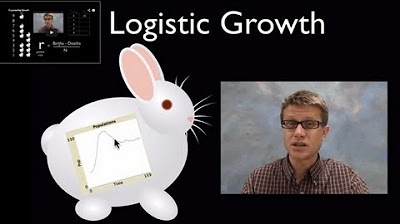Environmental Science. Lesson 10. Principles of Population Growth
Summary
TLDRThis lesson on population growth explores the principles behind exponential and logistic growth models. Exponential growth occurs when resources are abundant, resulting in rapid population increase, depicted by a J-shaped curve. In contrast, logistic growth emerges in resource-limited environments, showing initial rapid growth that eventually stabilizes as it approaches the carrying capacity, forming an S-shaped curve. Key factors influencing population dynamics include birth rates, death rates, immigration, and emigration. The discussion highlights the importance of sustainable population management, especially as governments implement measures to control human population growth.
Takeaways
- 🌱 Population growth models include exponential and logistic growth.
- 📈 Exponential growth occurs with unlimited resources, leading to rapid population increases.
- 🌀 Logistic growth happens when resources are limited, causing population growth to slow as it approaches carrying capacity.
- ⚖️ Key factors influencing population growth include birth rates, death rates, immigration, and emigration.
- 💔 Natality refers to the number of births, while mortality refers to the number of deaths in a population.
- 📥 Immigration is the influx of individuals into a habitat, while emigration is the outflow of individuals.
- 📊 The population density can be calculated using the formula: Natality + Immigration - Mortality - Emigration.
- 🦠 The intrinsic rate of natural increase (R) varies among species and influences growth rates.
- 🗺️ In nature, no population has access to unlimited resources, which leads to competition for survival.
- 👨⚖️ Governments implement controls to manage human population growth and ensure sustainability.
Q & A
What are the two main models of population growth discussed in the lesson?
-The two main models of population growth discussed are exponential growth and logistic growth.
What conditions lead to exponential growth in a population?
-Exponential growth occurs when resources are unlimited, allowing the population to grow rapidly in a j-shaped curve.
How does logistic growth differ from exponential growth?
-Logistic growth occurs when resources are limited, leading to an initial rapid increase in population followed by a slowdown as it approaches the carrying capacity, resulting in an S-shaped curve.
What are the four basic processes that affect population density?
-The four basic processes are natality (birth rates), mortality (death rates), immigration (incoming individuals), and emigration (outgoing individuals).
What is carrying capacity, and why is it important?
-Carrying capacity is the maximum number of individuals that an environment can support due to limited resources. It is important because it determines the sustainability of a population.
What factors can influence population growth?
-Factors influencing population growth include birth rates, death rates, immigration, emigration, food availability, and competition for limited resources.
What is the formula used to calculate population density changes?
-The formula is N(t+1) = N(t) + B + I - D - E, where N is population density, B is birth rates, I is immigration, D is death rates, and E is emigration.
What is the intrinsic rate of natural increase (r), and how does it relate to population growth?
-The intrinsic rate of natural increase (r) represents the potential growth rate of a population, calculated as the difference between birth rates and death rates.
What role do governments play in managing human population growth?
-Governments implement controls and policies to limit unsustainable human population growth, recognizing the impact of population size on resource availability.
Can a population grow exponentially forever? Why or why not?
-No, a population cannot grow exponentially forever because resources are finite, leading to competition and eventually limiting growth to the carrying capacity.
Outlines

Cette section est réservée aux utilisateurs payants. Améliorez votre compte pour accéder à cette section.
Améliorer maintenantMindmap

Cette section est réservée aux utilisateurs payants. Améliorez votre compte pour accéder à cette section.
Améliorer maintenantKeywords

Cette section est réservée aux utilisateurs payants. Améliorez votre compte pour accéder à cette section.
Améliorer maintenantHighlights

Cette section est réservée aux utilisateurs payants. Améliorez votre compte pour accéder à cette section.
Améliorer maintenantTranscripts

Cette section est réservée aux utilisateurs payants. Améliorez votre compte pour accéder à cette section.
Améliorer maintenant5.0 / 5 (0 votes)






